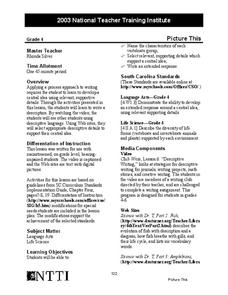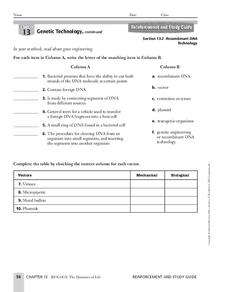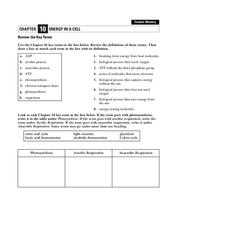Curated OER
Control of Eukaryotic Genes
Covering the molecular interactions involved with DNA packing and the control of gene activity in depth, this slideshow is useful for higher-level biology students. The biochemical components of protein translation are diagrammed and...
Curated OER
Cell Structure
Your accelerated biology learners will add to their understanding of cell structure with this resource. Taking them beyond the basics of mitochondria and chromatin, it also queries them about actin microfilaments and the extracellular...
Curated OER
Write a Description
Finding the central idea is the focus of this lesson. Middle schoolers write descriptions of different animals using details and descriptive language. They watch a video of kids using descriptive language, and then use showing language...
Curated OER
Vertebrate Skeletons
In this biology learning exercise, students examine the human skeleton and then classify animal bones according to their similar function.
Curated OER
Biological Relationships - Coral Reef Memory Game and Chain Game
Middle schoolers familiarize themselves with the interconnectedness of species within an ecosystem, and to use this knowledge to evaluate how the removal or decimation of one species can have far reaching effects.
Curated OER
Echinoderms
In this echinoderm worksheet, students will explore the characteristics of echinoderms including their body structures and larval stages. Then students will match the five classes of echinoderms to their descriptions. This worksheet has...
Curated OER
Mendel's Laws of Heredity
In this heredity worksheet, students will review the work Mendel did on predicting how traits were passed down from generation to generation. Then students will review monohybrid and dihybrid crosses and Punnett squares. This worksheet...
Curated OER
Genetic Technology
In this genetic worksheet, students will match 6 terms associated with gene engineering to their correct definition. Then students will complete a table indicating if the vector is mechanical or biological. Finally, students will...
Curated OER
When Heredity Follows Different Rules
In this heredity instructional activity, students will create 3 Punnett squares to determine the genotype and phenotype of the offspring from specific breedings. Then students will answer 7 true or false questions based on chromosomes...
Curated OER
Mendelian Inheritance of Human Traits
In this Mendelian inheritance worksheet, students will use a pedigree to complete 4 short answer questions about recessive and dominant traits. Then students will create a Punnett square. Finally, students will match 5 genetic disorders...
Curated OER
Chemistry Comes to Life
Although biochemistry of the human body is a vital topic, it doesn't have a chapter dedicated to it in many biology textbooks. If that's the case with your text, you can use this resource as a guide for designing your own lecture and as...
Curated OER
The Life And Times Of The Apple
Students engage in a study about the biology of apples that includes growth and reproduction. They conduct research using a variety of resources. Students write a description of an apple brought to class by answering several questions....
Biology Corner
Cell Theory Rap
All that this will link you to is a rap about cell theory and organelles. Use it as an example for a creative assignment in your biology class. Divide the class into groups and assign them a topic for which they write and perform a skit,...
Curated OER
Chapter 5: Socializing the Individual
In this socializing the individual worksheet, high schoolers respond to 6 multiple choice questions and 14 fill in the blank questions pertaining to how one learns to live within their culture.
Curated OER
Characteristics of Living Things
Seventh graders identify the characteristics of living and non-living things. In this biology lesson, 7th graders define vocabulary words as they go through the lesson. They answer a crossword puzzle after class discussion.
Curated OER
Evidence for Evolution
In this evidence of evolution worksheet, students review notes given by referring to the Nelson Biology text, chapter 11/13. Students read the notes and the specified pages in the text.
Curated OER
Embryology Word Search Puzzle
In this biology word search worksheet, students search for 36 terms related to embryology. They check off the words as they find them in the puzzle.
Curated OER
Classification
In this classification worksheet, students will look at how biological classification began and how scientific names are used in biology. Students will use a table showing the classification of four organisms to answer 10 short answer...
Curated OER
Energy in a Cell
In this cell energy worksheet, students will match 8 terms with their definitions relating to the biological processes that create energy in a cell. Then students will match 6 terms as being a part of photosynthesis, aerobic respiration,...
Curated OER
Organisms and Their Environment
In this organisms and their environment worksheet, learners will review concepts relating to ecological studies, levels of organization in ecology, and relationships between organisms in ecosystems. This worksheet has 10 fill in the...
Curated OER
Viruses and Bacteria
Reviewing the key terms and ideas from a chapter about viruses and bacteria, this activity helps students to reinforce their knowledge about the makeup and life cycle of a virus. Students answer true/false questions, blanks from a word...
Curated OER
The History of Life
In this Earth's history learning exercise, students will complete 5 true or false questions based on the early history of the Earth. Students will match 7 fossil vocabulary words to their definitions. Students will complete 4 short...
Curated OER
Mammal Characteristics
In this mammals instructional activity, students review the characteristics of mammals including their adaptations for survival and reproductive strategies. This instructional activity has 2 short answer, 5 matching, 5 fill in the blank,...
Curated OER
Diversity of Mammals
In this mammals worksheet, high schoolers compare and contrast the three types of mammals: placental, marsupial, and monotreme. This worksheet has 4 short answer, 12 matching, and 8 fill in the blank questions.























